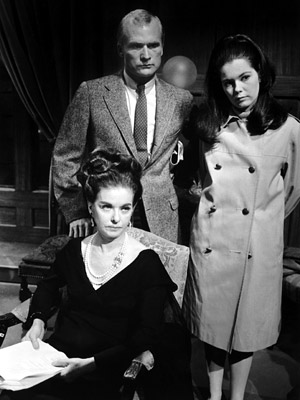 |
| A studio portrait of Joan Bennett, a natural blond |
Born to a family with theatrical roots going back to 18th-century England, Joan was the youngest of three sisters born to Richard Bennett, a popular stage and silent film actor and Adrienne Morrison, an actress, and literary agent. Her eldest sister, Constance, was once the highest-paid movie actress in Hollywood. Barbara, the second Bennett sister, was an actress and dancer.
 |
| Joan (left) with older sister Constance Bennett |
From Ingenue to Major Movie Star
In the early 1930s, under contract to Fox Film Corporation, she costarred with other bright newcomers like Spencer Tracy (twice). In 1932 she married movie producer Gene Markey—her first marriage to John M. Fox lasted from 1926-1928. Bennett’s marriage to Markey only lasted five years. Before her marriage to Markey ended, Joan left Fox and costarred in Little Women
 |
| Little Women was an important film for Bennett. |
Winds of Change
In 1938, Bennett, a natural blond, became a brunette for her role as Kay Kerrigan in Trade Winds, co-starring Fredric March. As a brunette, Bennett took on a whole new persona and was now being compared to the dark-haired beauty Hedy Lamarr. Bennett and Lamarr had more in common than their hair color. Lamarr married Gene Markey in 1939, two years after Bennett and Markey divorced. In 1940, Bennett and Wanger married.
 |
| This film defined Bennett's movie persona for the rest of her career. |
Almost Scarlett
Bennett was one of the dozens of actresses David O. Selznick tested for the role of Scarlett O’Hara in Gone With the Wind
 |
| Bennett in one of her screen tests as Scarlett O'Hara; David O. Selznick called her tests "magnificent." |
Lang's Favorite Noir Heroine
Probably Bennett’s most productive period was her work with director Fritz Lang. Under his direction, Bennett gave some of the best performances of her career. She played a prostitute in Lang’s Man Hunt
 |
| Bennett and Gregory Peck in a publicity still for The Macomber Affair |
From Femme Fatale to Perfect Wife and Mother
In 1950, Bennett starred in Father of the Bride
 |
| Bennett, like Myrna Loy, became the perfect wife and mother on film. |
Notes on a Scandal
On December 13, 1951, while Bennett was talking with her long-time agent Jennings Lang, Wanger shot Lang, thinking the two were having an affair. Both Lang and Bennett denied any personal involvement. The scandal put the brakes on Bennett’s film career. Supposedly, a third Father of the Bride movie had been planned but was scrapped.
 |
| Bennett played matriarch Elizabeth Collins Stoddard on TV's Dark Shadows. |
Pop Icon
Bennett managed to keep her name before the public by appearing on the legitimate stage and TV. It would be through TV that her career would take an unusual turn, making her a household name once again. In 1966, Bennett starred in the gothic daytime drama Dark Shadows, a cult hit that featured vampires, witches, warlocks, and werewolves. Bennett played family matriarch Elizabeth Collins Stoddard for the show's entire five-year run.
 |
| Bennett and Jack Albertson in an episode of Love American Style |
Later Career and Death
After the end of Dark Shadows, Bennett guest-starred on popular TV shows like Love American Style, as well as starring in occasional TV movies. Bennett had another chance at screen stardom in 1985 when she was offered the role of Bess McCarthy in Ron Howard’s Cocoon
A beautiful and glamorous movie star, Joan Bennett left a body of work that classic film fans will be studying for generations to come.




